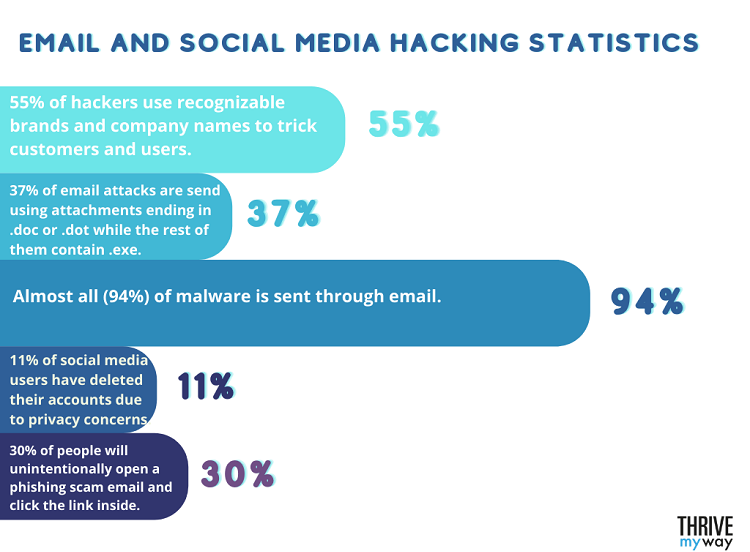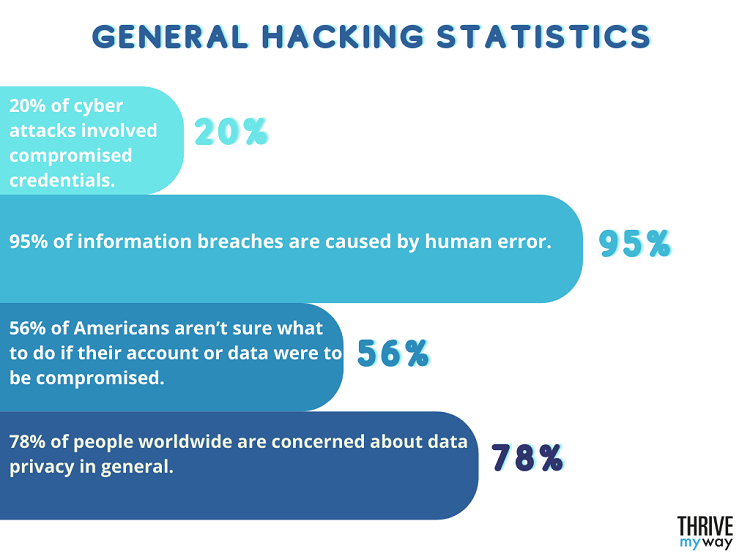Cyber attacks can happen to anyone – from multi-billion dollar corporations to individual civilians.
Here are a handful of hacking statistics to show just how prominent this issue is in the world.
Table of Contents
ToggleGeneral Hacking Statistics 2024
- 20% of cyber attacks involved compromised credentials.
- Every 11 seconds, another small business is attacked by a hacker or phishing scam.
- 95% of information breaches are caused by human error.
- On average, it takes 207 days to identify a security breach.
- 56% of Americans aren’t sure what to do if their account or data were to be compromised.
- 78% of people worldwide are concerned about data privacy in general.
- 2 out of 5 people believe their personal data isn’t worth anything to hackers.
Recent Hacking Statistics and Facts 2024
- Within the last 5 years, the FBI has received over 2.2 million complaints related to internet crime and cyber attacks.
- In Q1 2020, the number of security breaches increased by 273% compared to Q1 of the previous year.
- Since 2017, the number of phishing websites has increased by 130.5%.
- Over 36 billion records were exposed just in the first six months of 2020.
- The cost of a social security number on the dark web is $1. Credit card numbers sell for around $110, while passports cost up to $2,000 each.
The Costs of Hacking Statistics 2024
- By 2025, hackers are expected to have done over $10.5 trillion in damage.
- Small business scams only account for 4% of all cyberattacks, although it’s also responsible for the largest financial loss at $5.1 million per attack.
- Identity theft costs over $15 billion each year in the US alone.
- In 2019, the healthcare industry lost roughly $25 billion due to cyber attacks.
- For every individual breached account, companies can expect to lose $146.
- The average cost of a single ransomware attack is around $1.85 million.
Email and Social Media Hacking Statistics 2024

- 55% of hackers use recognizable brands and company names to trick customers and users.
- 1 out of every 4,200 emails sent in 2020 were phishing scams.
- 37% of email attacks are sent using attachments ending in .doc or .dot, while 19.5% of them contain .exe.
- Almost all (94%) of malware is sent through email.
- 1 out of every 13 interest requests is malware-related.
- 11% of social media users have deleted their accounts due to privacy concerns.
- ⅓ of all American adults don’t trust social media platforms when it comes to data protection.
- 30% of people will unintentionally open a phishing scam email, while 12% of those users will click the link inside.
IoT Hacking Statistics 2024

- Every month, there are, on average, 5,200 cyber-attacks on IoT devices.
- Almost 3% of all smartphone users have at least one app on their phone that could be considered high-risk.
- On average, IoT devices can be hacked in just 5 minutes.
- 47% of hacked at-home devices are cameras.
- The majority of IoT attacks originate in one of these five countries – China (21%), the US (11%), Brazil (7%), Russia (6%), and India (5%).
- Half of all mobile phone calls are scam-related.
Historic Breaches and Hacking Statistics
- In 2013, more than 3 billion Yahoo accounts were compromised, making the breach one of the largest in history.
- The hotel chain Marriott was hacked in 2020, resulting in a personal data leak of more than 5.2 million guests.
- Just two years prior, Marriott also announced that data from over 500 million accounts were also compromised between 2014 and 2018.
- The Equifax breach impacted 147.9 million customers, costing the company more than $4 billion in damage.
- In the 2016 Uber hack, 57 million users had their data leaked. Uber attempted to pay off the hackers to prevent the information from going public.
- In 2020, a cyber hack caused an IT failure at a hospital in Germany, leading to the world’s first cyber death.
- In 2018, more than 30 million Facebook accounts were breached. Only 1 million of those accounts managed to get away without having any data stolen.
You might be interested to check those related posts as well:
- 32 Password Statistics 2024 [Data Protection and Security]
- 22 Cool Data Privacy Stats 2024 [Protect Your Private Info]
- Top 10 [2023] Website Security Tools You Must Know
FAQ
How common is it to be hacked?
There are over 2,200 cyber-attacks reported each day, will thousands more happening under the radar.
On average, more than 800,000 people are impacted each year, making it one of the largest mass-scale crimes for businesses and individual users.
What percentage of hackers are caught?
The truth is – that most hackers never get caught. In fact, almost 80% of all cyber-attacks are never reported, making it hard for authorities to track down perpetrators.
Out of the cases that are reported, only 5% of hackers will be punished for their crimes.
What percentage of hacking is phishing?
Phishing (also known as social engineering) is the most common form of hacking. It is believed that 80% of all cyber attacks start with a phishing scam either through email, text message, or social media.
In 2021, companies involved in phishing scams lost $14.8 million.
Conclusion
The need for increased cyber security is crucial.
Not only will this save companies billions of dollars each year, but it will also protect users from falling victim to a vicious cyber-attack.
Sources:
- Find Stack
- Review42
- Varonis
- Norton
- DataProt





